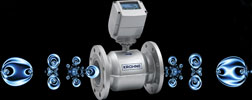

Drinking water and ground water are becoming increasingly scarce around the world. More than one billion people across the globe have no access to clean drinking water. At the same time, water consumption in prosperous countries continues to rise. It is doubtful whether this need can continue to be covered: By 2025, an increase in the need for drinking water of up to 45% is anticipated around the world. To avoid panic in the future, clever and long-term water management is needed today. However, this can only be as good as the measures and instruments used to implement it.
Strategy for saving
The current situation can be attributed mainly to a lack of infrastructure and water losses in the networks: water lines can break or be illegally tapped and excessive ground water withdrawal for irrigation purposes can become problematic. It is thus essential that leaks or illegal withdrawal points are detected as early as possible and suitable measures taken.
By using suitable water meters, losses can be detected and ground water withdrawal limited. Based on continuous flow measurement, they provide a flow profile of the measuring point for both day and night values. Unexpectedly high flow rates can be attributed to a leak behind the water meter in the absence of any other reason (eg, high water consumption during/after a big event). Conversely, a lower than normal flow could mean a leak in front of the device. State-of-the-art water meters can also measure the flow in both directions and display when the device is empty. That covers practically all flow situations that could occur in the water line. Ideally, the water meter can independently send out an alarm to the control station in the event of said peaks or low values and status.
Power constraints
In many cases however, such strategies are not easy to implement due to the lack of a reliable electricity supply. Krohne developed the new WATERFLUX 3070 battery operated electro-magnetic water meter specifically to overcome this situation. The heart of the device is the light metal measuring tube featuring a square cross section: the arrangement of the induction coils around the cross section produces a strong homogenous magnetic field allowing measurement to be independent of flow profile. This makes the extremely short inlets and outlets possible allowing the meter to be installed in very narrow standpipes and shafts. Highly precise measurement capability makes it suitable for custody transfer use as per OIML R-49 and MI-001. The device is available in nominal sizes from DN 25 to DN 600.
Even in countries with a high grid density, in Europe for example, there is great demand for a battery-operated water meter since the photovoltaic systems set up for the power supply at the measuring stations incur additional installation costs and are often vulnerable to vandalism and theft. Krohne has engineered a solution to this problem, the WATERFLUX is available with a range of converters to suit different application and power requirements. The IFC 100 and IFC 300 converters depend on external power supplies, while the IFC 070 makes it possible for the water meter to run on its own. The batteries integrated into the converter provide about 15 years of power for measurement at an interval of 15 seconds.
Compared to mechanical water meters, electromagnetic water meters feature far less pressure loss and boast the same long-term stability. In addition, modern devices offer crucial price advantages for large nominal sizes as in comparison to mechanical meters, the costs for sometimes necessary filters, flow splitters and maintenance and cleaning services are eliminated.
When there is no power supply, there is usually no wiring to the control system either. For this reason, the user is dependent on remote data transmission in the case of extremely remote water sources, standpipes or network transfer points. With the WATERFLUX, a data-logger with GSM transmitter can be optionally ordered as a compact module for the remote transmission of measurement data. The data-logger can be programmed to only send measurement data or to emit alarms in the event of specific operating states or flow values (right down to empty) which, for example, can be a sign of leaks or unexpected over-consumption. The module saves all flow data including peak values and low flows; the user thus obtains a precise flow value profile of the measuring station. The data-logger with GSM module for the WATERFLUX features its own battery which can deliver power for about eight years.
For more information contact Mahendra Rajcoomar, Krohne South Africa, +27 (0)11 314 1391, [email protected], www.krohne.com
| Tel: | +27 11 314 1391 |
| Email: | [email protected] |
| www: | www.za.krohne.com |
| Articles: | More information and articles about KROHNE |

© Technews Publishing (Pty) Ltd | All Rights Reserved